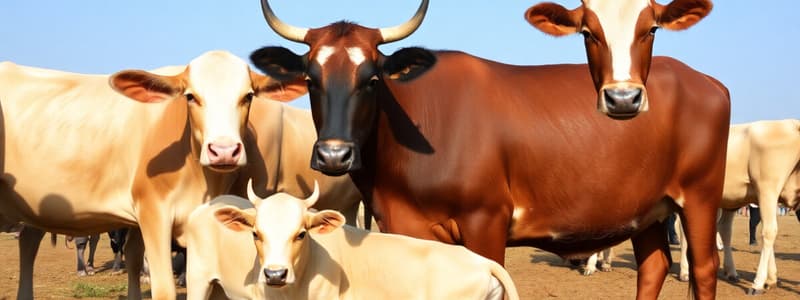Podcast
Questions and Answers
Which breed is known for having the largest milk yield?
Which breed is known for having the largest milk yield?
- Jersey
- Holstein Friesians (correct)
- Ayrshire
- British Friesians
Jersey cattle are known for having a high milk yield.
Jersey cattle are known for having a high milk yield.
False (B)
What is the weight range of Kerry cattle?
What is the weight range of Kerry cattle?
350-450 kg
Montbeliarde cattle are known for their good milk suitable for ________ making.
Montbeliarde cattle are known for their good milk suitable for ________ making.
Which breed originates from Scotland?
Which breed originates from Scotland?
Match the breed with their characteristics:
Match the breed with their characteristics:
Calves should be weaned off milk at six weeks of age.
Calves should be weaned off milk at six weeks of age.
What should be done to the calves' navels after birth?
What should be done to the calves' navels after birth?
What is the length of the gestation period for dairy cows?
What is the length of the gestation period for dairy cows?
Milk composition increases as the cow ages.
Milk composition increases as the cow ages.
What are the three main components of milk?
What are the three main components of milk?
Grass Tetany is caused by a lack of ______.
Grass Tetany is caused by a lack of ______.
Which disease in dairy cows is characterized by swollen and painful udders?
Which disease in dairy cows is characterized by swollen and painful udders?
Match the diseases with their causes:
Match the diseases with their causes:
Total Bacterial Count (TBC) measures the total number of dead bacteria in milk.
Total Bacterial Count (TBC) measures the total number of dead bacteria in milk.
The calving interval for dairy cows is ______ days.
The calving interval for dairy cows is ______ days.
Flashcards are hidden until you start studying
Study Notes
Cattle Breeds
- British Friesian: Originates from Holland, known for high flesh content.
- Holstein Friesian: Originates from the Netherlands, black and white markings, highest milk yield, low milk solids.
- Ayrshire: Originates from Scotland, red and white, known for easy calving, high protein milk.
- Jersey: Originates from Jersey, small brown breed, low milk yield, known for easy calving.
- Kerry: Rare breed, originates from Ireland, black coat, very docile.
- Montbeliarde: Originates from France, red and white coat, high protein milk suitable for cheese making.
- Norwegian Red: Originates from Norway, red and white coat with a small white patch on the head, high fertility.
Cow Terminology
- Calf: Young cow from birth to 9 months.
- Weanling: Calf that has been weaned from milk.
- Yearling: One-year-old animal.
Calf Rearing
- Mortality: Mortality rates can be reduced through proper management.
- Colostrum: Ensure colostrum is given to calves within 2 hours of birth.
- Housing: Well-ventilated housing reduces pneumonia risk.
- Weaning: Wean calves off milk and onto grass at six weeks, using a leader-follower system to increase weight gain and control parasites.
Replacement Heifers
- Breeding: Bred on the farm and kept for future milk production.
- Selection: Selected for good body condition score, healthy teeth, and hooves.
- Target Weights: Farmers aim for specific weights at various stages of growth for efficient production.
Production Cycle
- Oestrous Cycle: 21 days in length.
- Standing Heat: Lasts 18-24 hours.
- Gestation Period: 283 days.
- Lactation Stages:
- Early Lactation: 0-3 months
- Mid Lactation: 4-7 months
- Late Lactation: 7-10 months
- Dry Period: 60 days.
- Calving Interval: 365 days.
Milk Composition
- Composition: 87% water, 3.5% butter, 3.2% protein, 4.7% lactose.
- Factors Affecting Composition:
- Breed: Milk composition varies by breed.
- Age: Milk composition tends to decrease as the cow ages.
- Lactation Stage: Fat and protein content decreases as the lactation season progresses, but rises again towards the end.
- Health: Mastitis (udder infection) can significantly affect milk composition.
Milk Production
- Nutrients: Milk production relies on the nutrients the cow consumes.
- Alveoli: Nutrients travel to the alveoli in the udder where muscles squeeze the cells to release milk.
Milk Hygiene
- Testing: Milk undergoes hygiene tests at the creamery.
- Standards: Milk that fails to meet standards or contains antibiotics can result in fines and dumping.
- Hygiene Tests:
- Total Bacterial Count (TBC): Measures the number of living bacteria per ml of milk.
- Somatic Cell Count (SCC): Measures mastitis levels in the udder.
- Temperature Control: Milk should be cooled within 30 minutes to 4.0°C to prevent spoilage.
Diseases of Dairy Cows and Calves
- Mastitis: Caused by bacteria, characterized by swollen and painful udders. Requires antibiotics, and milk from affected cows cannot be used during the prescribed withdrawal period.
- Grass Tetany: Caused by magnesium deficiency. Prevented by ensuring adequate magnesium in the diet.
- Bacterial Scour: Caused by unhygienic conditions and high levels of bacteria in the stomach. Treated with antibiotics and good hygiene practices.
- Naval Ill: Leads to swollen navel and stiff joints. Treated with antibiotics, prevented by iodine dipping after birth.
- Viral Pneumonia: Caused by poor ventilation. Characterized by eye and nose discharge, coughing, and rapid breathing. Prevented by good ventilation in the shed.
Studying That Suits You
Use AI to generate personalized quizzes and flashcards to suit your learning preferences.




